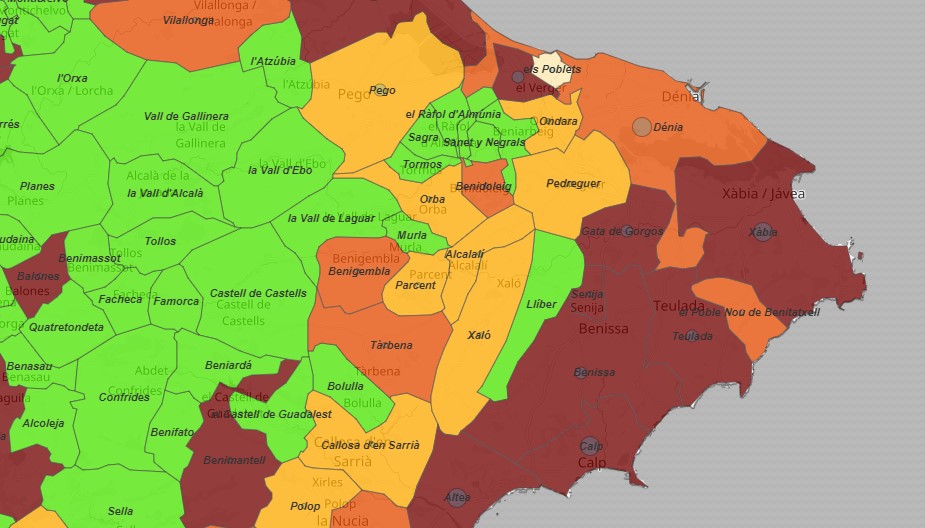VIRUS UPDATE: Marina Alta region suffers more than 520 positive cases detected in the past 14 days
Xàbia accounts for 110 of the positive cases detected in the past two weeks whilst Calp has seen 151 new cases in the same period.

Tuesday 13th July 2021 – Compiled by MIKE SMITH
The total number of positive coronavirus cases detected by PCR test in Xàbia has climbed to 1,628, according to the latest update from the regional health ministry. The number of cases detected in the past 14 days stands at 110 cases, which means that the municipality’s 14-day IA rate, a measure of the speed at which the virus moves through the population, has soared to to 392.63 cases per 100,000 inhabitants and the town remains in the ‘Extreme Risk’ alert level. There have been no new deaths in Xàbia since late March and the number remains at 12.
In the Marina Alta region, there have been 521 new positive cases detected in the past 14 days whilst the total number of positive cases since the pandemic began has been confirmed as 10,771 since the last update, a rise of 277:
- 97 – Calp
- 43 – Xàbia
- 39 – Dénia
- 22 – Teulada
- 21 – Gata de Gorgos
- 20 – Benissa
- 7 – Ondara
- 6 – Pedreguer
- 5 – El Vergel; Pego; Poble Nou de Benitatxell
- 2 – Orba
- 1 – Alcalalí; Benidoleig; Benigembla; Parcent; Senija
The region’s 14-day IA rate has risen to 303.00 cases per 100,000 inhabitants – almost eight times higher than it was two weeks ago – and the region is now in the ‘Extreme Risk’ category. There have been no new deaths since the last update and the region’s toll remains 203.
In terms of infection spread, Calp heads the table with 647.35 new cases per 100,000 inhabitants over the past 14 days and is joined in the ‘Extreme Risk’ category by Gata de Gorgos (464.52), Xàbia (392.63), Teulada (381.27), Senija (343.05), Benissa (274.63) and El Vergel (254.83).
At the ‘High Risk’ level are: Benigembla (225.73), Dénia (214.82), Poble Nou de Benitatxell (202.16), Benidoleig (185.53) and Beniarbeig (185.53).
At the ‘Medium Risk’ level are: Orba (134.41), Pego (128.29), Ondara (127.19), Parcent (103.41), Pedreguer (88.82), Alcalalí (76.80), Xaló (69.74).
At the ‘Low Risk’ level is Els Poblets (36.85).
There are now just 13 municipalities in the Marina Alta at the ‘New Normal’ level, mainly inland rural communities which have not recorded a single case in the past 14 days.
Spain
Spain’s 14-day IA rate is 368.03 cases per 100,000 inhabitants, which is 16.4% higher than two weeks ago, and the country remains in the ‘Extreme Risk’ category.
Consequently, the Positivity Rate, the measure of how many coronavirus tests return positive, has risen to 13.24%, almost double the value it was two weeks ago. A value of 5% or less indicates that transmission of the virus is more or less under control.
Hospitalizations across the country are starting to rise again with the percentage of beds in general wards occupied by patients suffering from COVID-19 more than doubling in two weeks to 3.24% and the percentage of beds in ICU wards occupied by COVID-19 patients rising to 7.87%, almost 14% higher than two weeks ago.
Across Spain, all but two of the 19 autonomous communities and cities have seen positive cases rise over the past two weeks (the Baleares and Cataluña had IT issues and couldn’t provide updates).
Despite not providing an update for the latest Ministry of Health report, Cataluña still leads the way with a general IA rate of 725.59 cases per 100,000 population over the past 14 days. Castilla y León is not far behind (620.73) as it suffers an infection spread rate rise of 878% compared to two weeks ago.
In response, several regions are already imposing new measures to stop the spread, fuelled mainly by the Delta variant, and have been targeting the night life sector. Infection spread is particularly worrying among the younger generation and in Cataluña, the 14-day IA rate for the 20-29 age group remains well above 2,100 cases per 100,000 population.
The newspaper El País has reported that Spain has become the hotspot of infection spread in the EU again, with only Portugal and Cyprus suffering higher rates of infection spread. The 14-day IA rate for Spain is well over 300 whilst Germany has slightly more than 7 per 100,000 people. Experts have offered several reasons for Spain’s high transmission rate: few controls of travelers, few social limits, and a greater spread of the virus among young people who have not yet been vaccinated and have assumed risky attitudes in their lifestyles, finishing the academic year keen to party along with the belief that they are invincible. In other countries, night life venues have remained closed or, in the case of the Netherlands which re-opened the venues not so long ago, have just closed them again.
Vaccination (12.07.21)
Spain has administered 47,777,316 doses of vaccine, which is 93.1% of those which it has already received. A total of 21,789,996 people have completed the recommended course, which is 51.7% of the total of the population which is to be vaccinated (40,129,822).
According to the latest data provided by the health authorities, 90.0% of people aged 40 and over in Spain have received at least one dose, with 74.9% having completed the recommended course.
The Comunidad Valenciana has administered 4,878,003 doses of vaccine, which is 92.9% of the total which it has received. A total of 2,236,307 people have completed the recommended course, which 49.8% of the population which is to be vaccinated (4,289,305).
According to the latest data provided by the health authorities, 90.6% of people aged 40 and over in the Comunidad Valenciana have received at least one dose, with 72.9% having completed the recommended course.
LINKS
- Actualización nº 416. Enfermedad por el coronavirus (COVID-19). 12.07.2021
- GIV COVID-19 Gestión integral de la vacunación COVID-19
- COVID-19 C. Valenciana: Monitoratge de la situació



